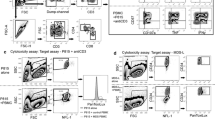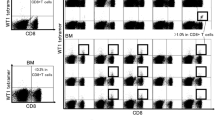Abstract
The proliferative response of T-cells to autologous non-T-cells is referred to as the autologous mixed lymphocyte reaction (AMLR). Recent studies have suggested that AMLR represents a mechanism of immune regulationin vivo. We investigated AMLR in patients with acute- and chronic myeloid leukemia (AML and CML). AMLR was found to be significantly depressed (P<0.001) in AML patients (n=17, cpm=532±95) and CML patients (n=13, cpm=688±99) when compared with that of their healthy HLA-identical siblings serving as controls (n=17, cpm=4152±619 and n=13 cpm=4086±421, respectively). In order to understand the cellular basis of the defective AMLR in patients with AML and CML, we performed mitogen-treated T-cell cultures analysis of T-cell subsets and HLA-II antigen detection on monocytes. The results indicated that the defect of AMLR in patients resided at the stimulator monocyte level rather than at the responder T-cell level. Enumeration of monocytes reactive with monoclonal antibody Tü22, which recognizes determinants of HLA-DQ, demonstrated that ML patients had a significantly decreased (P<0.001) number of circulating Tü22+ monocytes when compared with normal controls. These studies suggest that a deficiency of HLA-DQ+ monocytes contributes to the depression of AMLR in ML and possibly underlies the abnormalities of immune response present in this disease.
Similar content being viewed by others
References
Opelz G, et al. Autologous stimulation of human lymphocyte subpopulations. J Exp Med 1975; 142: 1327.
Gatenby PA, et al. The regulation of antibody-secreting cells generated in the autologous mixed lymphocyte reaction in man. Behring Inst Mitt 1983; 72: 143.
Beale MG, et al. Stimulating cell types in the autologous mixed lymphocyte reaction in man. J Immunol 1980; 124: 227.
McDermott RP, et al. Further characterization of the human autologous mixed lymphocyte reaction (MLR). J Immunol 1981; 126: 729.
Mingari MC, et al. Role of Ia antigen in the human autologous mixed lymphocyte reaction. Eur J Immunol 1982; 12: 98.
Terasaki PI, et al. Microdroplet assay of human serum cytotoxins. Nature 1964; 204: 998.
Wernet P, et al. Monoclonal antibodies against Ia-like antigens inhibiting HLA-D and/or SB-directed secondary proliferative responses. Transplant Proc 1983; 15: 94.
Muller C, et al. Divergent expression of HLA-DC/MB, and-SB region products of normal and pathological tissues as detected by monoclonal antibodies. J Immunol 1985; 169: 228.
Smolen JS, et al. The human autologous mixed lymphocyte reaction suppression by macrophages and T-cells. J Immunol 1981; 127: 1987.
Rebinowitz M, et al. Cell shape changes induced by cationic anethetics. J Exp Med 1976; 143: 190.
Thiele DL, et al. Phenotype of the accessory cell nesessary for mitogen-stimulated T- and B-cell response in human peripheral blood: Delineation by its sensitivity to the lysosomotropic agent, I-leucine methyl ester. J Immunol 1983; 131: 2282.
Vorlaender KO, Immunologie, 2. Auflage, Georg Thime Verlag. New York: Stuttgart. 1983.
Kuntz MM, et al. Lymphocyte transformation induced by autologous cells. IV. Human T-lymphocyte proliferation induced by autologous or allogeneic non T-lymphocytes. J Exp Med 1976; 143: 1049.
Weksler ME, et al. The autologous mixed lymphocyte reaction. Advances in Immunology 1981; 31: 271.
Rosenberg YJ, et al. The basis of autoimmunity in MRL-lpr/lpr mice: a role for self Ia-reactive T-cells. Immunology Today 1984; 3: 64.
Gupta S. Autologous mixed lymphocyte reaction in health and disease states in man. Vox Sang 1983; 44: 265.
Begemann H, et al. Klinische Hamatologie, 3. Auflage, Georg Thieme Verlag. New York: Stuttgart. 1986.
NG. KC and Russell AS. Factors influencing the autologous mixed lymphocyte reaction in normal subjects. J Immune Method 1982; 52: 115.
Davey FR, et al. Association of HLA-DR antigens with the autologous mixed lymphocyte reaction. Tissue Antigens 1984; 24: 98.
Kozak RW. Lymphocyte proliferation induced by autologous cells. XV. Relationships between the human autologous mixed lymphocyte reaction stimulated by non-T and activated T-cells. Human Immunology 1985; 14: 351.
Huber C, et al. The role of adherent HLA-DR mononuclear cells in autologous allogeneic MLR. J Immunol 1981; 127: 726.
Halloran PF, et al. The regulation of expression of major histocompatibility complex products. Transplantation 1986; 41: 413.
Nunez G, et al. Cytofluoremetric analysis of major histocompatibility antigens on human monocytes using monoclonal antibodies. Hum Immunol 1986; 6: 1.
Gonwa TA, et al. Antigen-presenting capabilities of human monocytes correlates with their expression of HLA-DS, an Ia determinant distinct from HLA-DR. J Immunol 1983; 130: 706.
Raff HV, et al. Macrophage heterogeneity in man, a subpopulation of HLA-DR-bearing macrophages required for antigen-induced T-cell activation also contains stimulators for autologous-reactive T-cells. J Exp Med 1980; 152: 581.
Tamashita U, et al. The syngeneic mixed lymphocyte reaction in mice. J Immunol 1982; 128: 1003.
Goyert SM, et al. Isolation of I-A subregion-like molecules from subhuman primates and man. Nature 1981; 294: 266.
Silver J, et al. Structureal studies of murine 1-E and human DR antigens. Mol Immunol 1979; 16: 37.
Radka SF, et al. Review: Class II molecules of the major histocompatibility complex considered as differentiation markers. Hum Immunol 1986; 16: 390.
Gong FL and Grosse-Wilde H. Impaired antigen-presenting capabilities of monocytes correlated with their decreased expression of HLA-II antigens in patients with myeloid leukemia (in press).
Author information
Authors and Affiliations
Rights and permissions
About this article
Cite this article
Feili, G., Grosse Wilde, H. Impaired autologous mixed lymphocyte reaction correlated with decreased expression of HLA-I antigens on monocytes in patients with myeloid leukemia. Chinese Journal of Cancer Research 3, 11–17 (1991). https://doi.org/10.1007/BF02671284
Issue Date:
DOI: https://doi.org/10.1007/BF02671284




